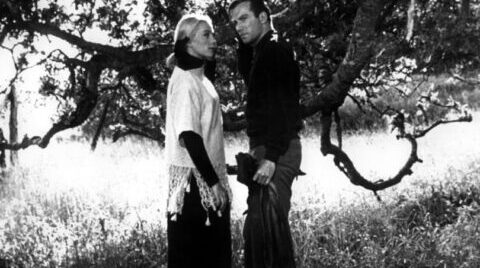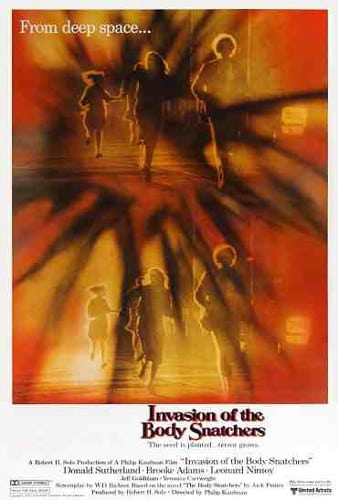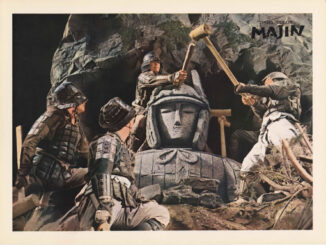Incubus (1966)
Directed by: Leslie Stevens
Written by: Leslie Stevens
Starring: Allyson Ames, Eloise Hardt, Robert Fortier, William Shatner
USA
AVAILABLE ON 4K ULTRA HD BLU-RAY [LIMITED EDITION] AND STANDARD BLU-RAY: 13th January, from ARROW VIDEO
RUNNING TIME: 74 mins
REVIEWED BY: Dr Lenera

The village of Nomen Tuun has a well that can supposedly heal the sick and make people more beautiful, but because of the latter many dodgy people pay a visit, eventually creating an environment where Succubi lure folk to their deaths in order to offer their souls to Hell. Succubus Kia is tiring of this; it’s too easy, and these souls are going to Hell anyway. Despite her sister Amael warning her of the danger that a pure soul will bring [love], Kia sets out anyway to seduce a good person, and sets her sights on Marc, a soldier who, with his sister Arndis, has come to the sacred water to heal his battle wounds….

Esperanto isn’t mentioned much these days, so it night be worth me quickly explaining what it is. It’s a language that was created in the late 1870s and early 1880s by L. L. Zamenhof, a Jewish ophthalmologist from Bialystok, then part of the Russian Empire, but now part of Poland. Zamenhof said that he created the language to reduce the “time and labour we spend in learning foreign tongues”, and to foster harmony between people from different countries: “Were there but an international language, all translations would be made into it alone … and all nations would be united in a common brotherhood.” Beginning in 1908, there were several efforts to establish the world’s first Esperanto state in Neutral Moresnet, which at the time was a Belgian-Prussian region in Europe, and two micronations – Rose Island near Italy in the Adriatic Sea, and Molossia near Dayton, Nevada, use Esperanto as their official language to this day. It’s supposed to be the world’s most spoken language, though I’ve never come across it personally. In any case, it’s therefore perhaps of little surprise to learn that Incubus wasn’t even the first movie to be filmed in the language, but it would be a very odd piece even if the people in it spoke English. An arty semi-horror movie, made by most of the production team who made that amazing science fiction TV show The Outer Limits, starring no less than William Shatner, which some say was cursed because of multiple tragedies involving people in it, just after its making, and was even lost for a great many years? That absolutely screams curiosity value, but thankfully the film is as strange and interesting as you’d hope for, one that’s just about to properly realise its story with its tiny budget. It’s a relatively basic, even minimalist struggle between good and evil but with elements bordering on the abstract and with a real hypnotic quality. Sort of early Ingmar Bergman meets Carnival Of Souls meets The Outer Limits, though Incubus is really too unique to describe in that way.
The Outer Limits was cancelled, so producer Leslie Stevens wrote a horror script to make use of the team he’d brought together. It was producer Anthony M. Taylor who chose Esperanto as its language. The script was translated into Esperanto, and the actors rehearsed for 10 days to learn their lines phonetically. Principal photography took place over 10 days in May 1965. location shooting occurring at Big Sur Beach and at the Mission San Antonio de Padua near Fort Hunter Liggett in Monterey County. Concerned that the authorities wouldn’t let them shoot a horror film at the Mission, Stevens told them that the title was Religious Leaders of Old Monterey, and showed them a different script about monks and farmers. A hippie thrown off the set “cursed” the film. The premiere took place at the San Francisco Film Festival on October 26, 1966, where, after there initially being no sound, 50 to 100 Esperanto enthusiasts “screamed and laughed” at the actors’ poor pronunciation. Because of its Esperanto, actor Milos Milos killing his married girlfriend Carolyn Mitchell then himself, and actress Ann Atmar also committing suicide, Taylor and Stevens couldn’t find any distribution except in France. Later on the “curse” continued with strange and sad fates befalling people who’d been involved. In 1968, Taylor shot some colour nude footage and Shatner even recorded part of a narration that was intended to replace the Esperanto, but this release didn’t happen. In 1993 he was told by the company that stored the negative, film elements, and prints that all were probably destroyed in a fire, so no video release. Three years later, a print was discovered in the permanent collection of the Cinémathèque Française in Paris, but it was in poor condition and had French subtitles; a new master had to be made by optical printing and was released on DVD in 2001. Arrow’s release is sourced from a different print found in 2021.
The opening titles sure get you into the right mood with its prints of woodcarvings of demonic creatures and unsettling swirling harp-dominated music which viewers of The Outer Limits will certainly recognise, followed by narrated scene-setting that will remind many of the ‘Control Voice.’ The odd filming style begins right away with the first shot of the movie proper being of an idyllic woodland, but it only last one second before there’s a very slow dissolve into another area of the same forest, and only now does the camera linger and slowly pan right to a house with a huge branch in the foreground. This kind of filming, which continues, should probably result in a disjointed product, but I found it very easy to get into the film’s strange, dreamlike mood. In the first of a number of memorable images that are repeated with variations, a hooded figure stands on a high rock overlooking the sea, pointing three times at the sky, before we cut to this well that’s attracted both humans, lured by the promise of being healed and looking nicer, and demons who lure men to their doom. A no doubt typical example is then shown, with a man filling his cup with water but spitting it out because it tastes of salt. “Are the marks on my face gone? Am I young? Beautiful?”. Also rather tipsy, he converses with a pretty lady who’s sitting on a tree branch. She seems to be sexually available to him, but he has to chase her and is prone to falling over and injuring himself. It’s a fun realisation of how far a man might be willing to go for sex, and the scene is lengthy, but keeps up the interest until, eventually, in the sea by a beach, she puts her foot on his head and drowns him while the camera shakes considerably, then performs some weird ceremony which we only seem to see a part of before her sister Amael and some evil monks approach her.

Amael seems impressed by the fact that Kia has sent three guys to their master [basically The Devil, I guess, though he’s never referred to as such], but Kia is sad. “Why waste our powers herding swine? I am weary of luring evil ugly souls into the pit….surely the god of darkness would welcome the capture of a noble soul?….I want to find a saint and cut him down.” Well, we all like a challenge, so we can perhaps understand Kia now going off and firstly settling on a priest, though, in a rather amusing moment, he seems to be a sort of satanist, holding a frog, burying something wrapped in cloth and kneeling to worship at a crucifix which he turns round. So she literally runs to a nearby cathedral where we meet our hero, coming out of the main door with his sister, going to visit the well. The water tastes good to him, which, seeing as it tasted foul to the previous drinker, is literally the only possible proof that we, as viewers, have of the reputed mystical powers of this well, and anyway tastes can differ. Marc and Arndis walk the long way back to their house, with Kia following. Amael tries to put Kia off, but Kia is hooked, and visits Marc while Amael is blinded by looking at the sun after an eclipse – or did Amael cause it? These Succubi do have powers but some things are ambiguous. The very quick and very genuine attraction between the two convinces. He doesn’t believe in doing “it” before marriage, but he doesn’t take much convincing to go ahead anyway, outdoors of course. Then he takes her to the cathedral where she can’t handle the religious things inside and flees. Amael and Kia want revenge on Marc for “defiling her” with an “act of love” and summon up an Incubus!
Some possible confusion as to how fantastical Incubus doesn’t really harm matters, nor the prolonged scenes of people walking about in the woods, probably shot to pad out the running time as quickly as possible; they reinforce the idea that nature might be the truly dominant force. The Incubus features in a few genuine scenes of horror, including his awakening where, after a glimpse of a demon with bat-like wings in the distance, we see a man claw his way out of the ground, which soon makes sense as this particular demon has to be appealing to women, though this doesn’t stop him from hanging upside down and suddenly looming into view, not to mention committing rape surrounded by Succubi in another scene which we quickly cut away from though which is still quite nasty for the time. A sense of terror does increase as does the pace, though typical shock tactics, even of the time, are generally avoided even if the good vs evil struggle depicted is scarcely more sophisticated than something like Dracula Has Risen From Grave, Hammer’s most overtly religious-themed film, two years later. The bad creature changed or confused by love – or is Marc just a bloody good shag? – is merely one of several well-worn tropes utilised here, and the heavy Christian-favouring element may seem a bit too much for some viewers today, not to mention the fear of female sexuality, though the latter is a very common archetype so hardly worth complaining about, in a tale which does go down at least one surprising and commendably dark pathway, and climaxes with ambiguity which surely a lot of us love?
Of course it’s very much about the handling. Devices like unusual framing and strange choice 0f lighting are frequently applied. There are several memorable shots, such as Kia seeming to disappear into a black wall, somebody shown walking in the grass through windows, and a house at night enveloped in fog. The forest footage is shot low contrast with slight gauze filters, also helping to lure the viewer into a particular state of being. cinematographer Conrad L. Hall truly showcasing how evocative black and white photography can be. Even without Dominic Frontiere’s music cues which, while tense and eerie, are all reused from The Outer Limits and maybe other TV shows he scored, fans of that series ought to love Incubus because in some ways it’s a development of its aesthetics. And then there’s a acene towards the end where Shatner, accompanied by white blurry cloudu things [who needs elanborate special effects?] has a monologue about – well I’m not sure really but if you’re a Shatner fan then you really need to see and hear it – though things only partially lose it [or may become even better for some] when a cuddly-looking goat becomes involved in the action. Returning to the Shat, he’s often criticised for his simplistic, direct style of over-acting, sometimes by people who love to mock [let’s not go into his music excursions]., but I couldn’t fault his performance here. Unfortunately I can’t say the same for the other performers, though we do get a real sense of the close, loving bond between Marc and his sister Arndis despite the rather dreadful emoting of Eloise Hardt. Indeed Incubus seems to overcome such things to become a genuine minor classic of arty horror.
4K ULTRA HD LIMITED EDITION CONTENTS
4K restoration from the last surviving 35mm print by Le Chat Qui Fume
I didn’t actually expect Incubus to look that great, but ended up being considerably impressed. The look is very high-contrast except for the forest scenes which are the opposite, but I’d have thought that’s how the film was supposed to look. Blacks are deep, grain is mostly even and damage is minimal. The 2001 version blocked out the imbedded French subtitles with black boxes. This one cuts just cuts most of them off with the framing; one can sometimes glimpse them when there are two levels of text. Of course that’s not ideal, but it’s surely the best that the restorers could do.
4K (2160p) Ultra HD Blu-ray presentation in Dolby Vision (HDR10 compatible)
Original lossless Esperanto mono audio
Optional Esperanto subtitles for the deaf and hard-of-hearing
New audio commentary by writer and genre historian David J. Schow, author of The Outer Limits: The Official Companion
Schow begins by saying that he did a commentary for this movie two decades ago and is “determined not to screw it up this time”. I doubt he screwed it up the first time, but I do like it when experts revisit a film in this way; Tim Lucas has done it for some Mario Bavas. Despite rarely being scene specific, he soon shows that he’s the right person for the job, even having read the original screenplay which was altered to tone down the religion element. He avoids talking about the many sad incidents that took-place after filming, but we learn a considerable amount about a variety of other stuff, including the fake script [it seems hilarious!], Steven’s production group where Frontieri was second in command, and Francis Ford Coppola claiming to have seem the nudie version even though it supposedly wasn’t released. And apparently Shatner, while filming Star Trek, had a rock with a threatening letter on it thrown through the window of his trailer by an Esperanto speaker who was angry at not having been consulted for the film, and later claimed that he destroyed all copies! Oh – and there’s a website devoted entirely to Shatner’s toupees. Must visit.
Archive audio commentary by star William Shatner
There are a lot of long gaps in Shatner’s track for the 2001 DVD, and he sometimes resorts to repeating himself like praising Hall’s work and uttering single words like “fantastic“, but it’s still a really fun and actually rather unique mixture of recollection, admiration and oddness, though, saying that, it may not surprise those who are familiar with the man. He says that nobody understood what others were saying during filming which added to the film’s strangeness, that the French loved it “because they don’t understand it, they can’t understand each other”, believes that the curse was real and so powerful that it even caused Esperanto to become less spoken, and says that Milos Milos, who played the Incubus, got annoyed at him for addressing him by his first name even though it’s the first as his second. This is an essential commentary and one of those that I’ll probably replay.
Archive audio commentary by producer Anthony Taylor, cinematographer Conrad L. Hall and camera operator William Fraker
I found this track, which is also ported over from the DVD, to be a bit disapointing, Despite having four participants, they leave a lot of gaps and seem to run out of stean, perhaps because they’d already spoken about the film in one of the featurettes listed below. Schow moderates, and he and Taylor talk the most while Hall says little [though his comment that “there should be more space on the sides” is interesting] and Fraker hardly anything until we come to the final scene which he photographed; the goat was called Billy and had just been in a beer advertisement. Taylor is most interesting when he’s discussing the difficult restoration, with only one, poor print and one copy of the script to use to do new English subtitles, and Stevens, who by dong things like rocking plants would often “double the value of a shot for no money”. This is a solid listen but could have been better.
Alternate 1.37:1 presentation of the film (1080p only)
Words and Worlds: Incubus and Esperanto in Cinema, a newly filmed interview with genre historian Stephen Bissette [43 mins]
Bisette, who doesn’t seem to mind being shown referring to his notes, discusses Esperanto, its use in movies which is larger than you might hhavec expected, and Incubus itself in a very informative piece that repeats very little of what we’ve heard before. We’re reminded that writers such as Edgar Rice Burroughs and H.P.Lovecraft created languages, and learn that, for a period of time, some science fiction writers and fans believed that Esperanto would be the main language spoken in the future, and about the first Esperanto film which its writer and director tried to destroy all copies of. Bisette finishes by talking about Christopher Mihm, whose movies can be seen on DVD in Esperanto or with Esperanto subtitles. Odd though that Bisette seems to think that viewers would be watching this featurette before they watch the film.
Internacia Lingvo: A History of Esperanto, a newly filmed interview with Esther Schor, author of Bridge of Words: Esperanto and the Dream of a Universal Language [22 mins]
Schor goes far more into detail about Esperanto, though is able to get pretty technical while not losing the viewer. It seems that Zamenhof also created so that people from difficult countries can read great literature. In any case, it never caught on the way he wanted, even in the ’20s which is when its use was at its peak. Schor believes that Yiddish was the main basis for the language which uses elements of a lot of other languages and combines words to make new words. Schor concludes her piece with the state of Esperanto today..
An Interview with the Makers of Incubus, an archive interview by Schow with Taylor, Hall and Fraker [19 mins]
As I said when discussing the audio commentary featuring the very same people, it might be preferable for viewers to watch this featurette before. This is because the participants, who are just about to see the restored film in 2001, discuss many of the more important aspects, even if we’ve already heard them from others, and don’t run out of things to say. Taylor again does most of the talking, and recalls that many people tried to talk him out of using Esperanto even though he and others didn’t think it was a big deal seeing as many films not in English were doing well in cinemas. Hall says a few things about the filming while Fraker contributes hardly anything.
Video trailer
Reversible sleeve featuring newly commissioned artwork by Richard Wells
Illustrated collector’s booklet featuring new writing on the film by Frank Collins and Jason Kruppa







Esperanto is mostly a streamlined Romance language (similar to Spanish or Italian). It’s much easier to learn than most languages, and around two million people speak it today! Check out esperanto-usa.org.